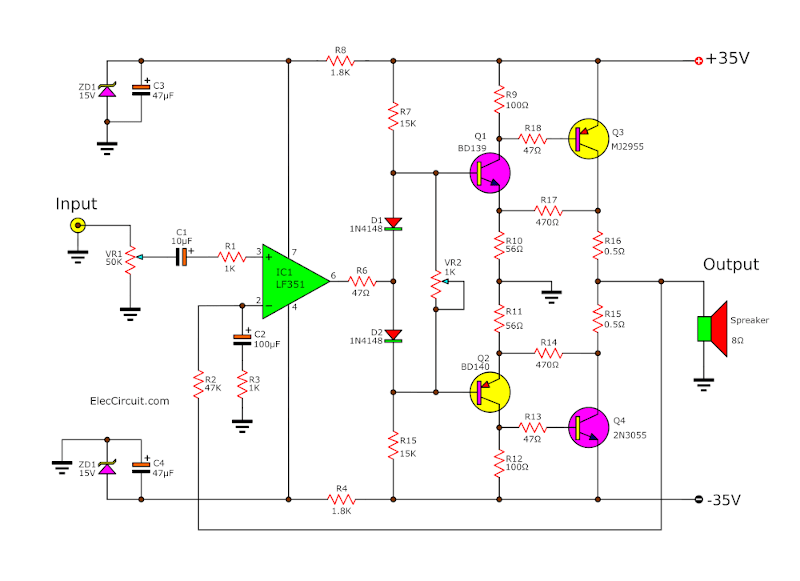Differentiation Amplifier

Differentiation amplifier
A differentiator circuit (also known as a differentiating amplifier or inverting differentiator) consists of an operational amplifier in which a resistor R provides negative feedback and a capacitor is used at the input side. The circuit is based on the capacitor's current to voltage relationship.
What is difference between amplifier and differential amplifier?
The main difference between differential amplifier and operational amplifier is that a differential amplifier is an amplifier that amplifies a voltage difference between its inputs, whereas an operational amplifier is, in fact, a type of differential amplifier with a large open-loop gain, a high input impedance and a
Why it is called differential amplifier?
However, we are able to conjointly connect signals to each of the inputs at the same time designing another common form of op-amp circuit which is called as a differential amplifier. It is basically used as a building block of an operational amplifier which is called as operational amplifier (op-amp).
What are the types of differential amplifiers?
The four differential amplifier configurations are following:
- Dual input, balanced output differential amplifier.
- Dual input, unbalanced output differential amplifier.
- Single input balanced output differential amplifier.
- Single input unbalanced output differential amplifier.
What differentiator means?
Definition of 'differentiator' 1. a person or thing that differentiates. Computing. an electronic device whose output signal is proportional to the derivative of its input signal.
What is use of differentiator opamp?
This op-amp is mainly used for enhancing low signal levels. An op-amp differentiator can be active or passive based on the components used in designing. It is basically a high pass filter and we will use this differentiator amplifier in frequency modulators and wave shaping circuits.
What are the features of differential amplifier?
Features of Differential Amplifier:
- Differential voltage gain is high.
- Common mode gain is low.
- CMRR (common mode rejection ratio) is high.
- Input impedance is high.
- Wide bandwidth.
- Low offset voltages and currents.
- Output impedance is low.
What is the output of differential amplifier?
Differential amplifiers have two inputs and one output, the output signal being proportional to the difference in signals between the two inputs. The voltage output of a differential amplifier is determined by the following equation: Vout = AV(Vnoninv - Vinv)
What is differential amplifier using BJT?
The typical BJT differential pair amplifier consists of a pair of transistors coupled at the emitters to a current source, having equal resistances in each collector and equal but opposite, signal sources in each base. The amplifier has several variations on this basic configuration.
What are the advantages of differential amplifier?
Advantage of differential amplifier: Differential amplifiers provide increase noise immunity: When using differential amplifiers, it responds to the only difference signal between input terminals and also ignores all common-mode signals such as noise pick–up and the ground voltage.
Which differential amplifiers are more used?
Instrumentation Amplifiers (in-amps) are very high gain differential amplifiers which have a high input impedance and a single ended output. Instrumentation amplifiers are mainly used to amplify very small differential signals from strain gauges, thermocouples or current sensing devices in motor control systems.
What is differential amplifier PDF?
Differential amplifier is a basic building block of an op-amp. The function of a differential amplifier is to amplify the difference between two input signals. Let us consider two emitter-biased circuits as shown in figure 2.1.
What is difference between integrator and differentiator?
A differentiator circuit produces a constant output voltage for a steadily changing input voltage. An integrator circuit produces a steadily changing output voltage for a constant input voltage.
What is the gain of differential amplifier?
The gain of a difference amplifier is the ratio of the output signal and the difference of the input signals applied.
What is single-ended differential amplifier?
ADI single-ended to differential amplifiers enable the processing of both single-ended inputs to complementary differential outputs or differential inputs to differential outputs. This provides a convenient solution when interfacing with analog-to-digital converters (ADCs).
Why capacitor is used in differentiator?
The capacitor blocks any DC content so there is no current flow to the amplifier summing point, X resulting in zero output voltage. The capacitor only allows AC type input voltage changes to pass through and whose frequency is dependant on the rate of change of the input signal.
What is ideal differentiator?
Ideal Differentiator: The non-inverting input terminal of the op-amp is connected to ground through a resistor Rcomp, which provides input bias compensation, and the inverting input terminal is connected to the output through the feedback resistor Rf. Thus, the circuit behaves like a voltage follower.
What's another word for differentiator?
| determiner | identifier |
|---|---|
| contraster | discerner |
| discriminator | recognizer |
What is the application of differentiator?
Differentiating amplifiers are most commonly designed to operate on triangular and rectangular signals. Differentiators also find application as wave shaping circuits, to detect high frequency components in the input signal.
What are the advantages of integrator and differentiator circuit?
The proposed circuits have the following advantages over the tradi- tional circuits. 1) Single time constants are obtained for both circuits. 2) Resistive inputs, without using input buffers, are obtained for both circuits. 3) The integrator is dc stable and the differentiator action ceases at high frequencies.











Post a Comment for "Differentiation Amplifier"